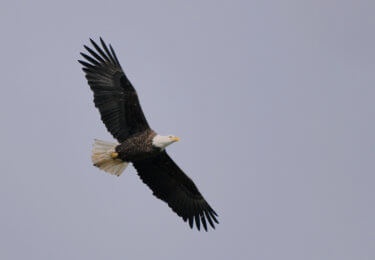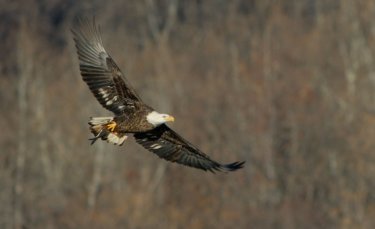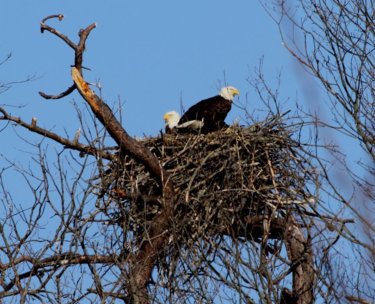Nature Conversations: Bald Eagle Edition
Since Bald Eagles are busy nesting at our preserves, including Glades Wildlife Refuge and Bryn Coed Preserve, now is a great time to learn about these iconic birds.
Our expert this time was Debbie Beer, the Director of Volunteer Engagement here at Natural Lands. An avid birder, Debbie has traveled to a dozen countries for birding and wildlife safaris.
Here’s the conversation we had with Debbie, originally held on our Facebook page.
Bald Eagles
Debbie: Hi everyone. I’m thrilled to highlight one of my favorite birds: the Bald Eagle! It was the species that got me hooked on birding 25+ years ago when one soared over my head.

Photo: Bill Moses
How long do they typically live in the wild?
Eagles live about 20-25 years in the wild. The longest survivor in the wild was 38 years old. Decades of eagle banding has provided this type of great data.
How long from hatch to fledge?
From hatch to fledge takes about 3 months. Both parents take an active role in protecting and feeding the chicks. When they finally take-off from the nest, the offspring are the same size as the adults, but all-dark.
Are bald eagles’ numbers in danger?
Fortunately, Bald Eagle populations are on the rise, and doing well. There are more than 10,000 nesting pairs in the US, more than 300 in Pennsylvania. Up from only 3 pairs in 1973, when the species was listed as federally endangered. Eagles (and many other birds) were significantly impacted by the pesticide DDT, which weakened their eggshells so they could not reproduce.
I was at Bryn Coed a few weeks ago and saw one of the eagles perched in a tree and then soaring over the fields. It was amazing! Especially since I grew up fearing that eagles were headed for extinction. Debbie – do you know how many eagles there are in our region now compared to the 70s and 80s?
Bald Eagles have made a remarkable comeback since their numbers were decimated by the pesticide DDT. They reached a low of 3 breeding pairs in the late 1970’s, before introduction programs were launched in the 1980’s. Today, there are more than 300 breeding pairs in PA, more than 10,000 in North America. Their numbers grow each year.

Photo: Bill Moses
Above it says there is a nest at Bryn Coed Preserve. Can you see it on a trail?
Yes. Our Bald Eagle’s nest at Bryn Coed is visible from the red trail. Look keenly, as it’s well camouflaged under pine branches. Look UP too. You might see them flying overhead!
How long has this nest been here (Bryn Coed Preserve) and active?
We’re not sure exactly how long Eagles have been nesting at Bryn Coed. Natural Lands has managed Bryn Coed for just a few years. Locals tell us they think it’s been there at least 7 years. We know that last year, 2019, they fledged 3 healthy offspring!
Are there chicks in the Bryn Coed nest?
Answer: We’re not quite sure if chicks have hatched yet at Bryn Coed. We know they’ve been incubating since early March (though we don’t know the exact egg-laying date). Eggs would be due to hatch any day now, if not already.

Photo: Brian Johnson
How many chicks have the Bryn Coed eagles had in the past couple of years and have they nested nearby? Any eggs or chicks in the nest now?
Last year, the Bryn Coed eagles raised 3 healthy offspring. A good year, as the average is 2. They are currently incubating eggs, which are due to hatch any day. (incubation takes 31 days).
Is the area where the nest (at Bryn Coed) is located barriered off to prevent people from spooking them?
There are signs alerting folks not to approach the area. Visitors are reminded to stay on trails at all times, too.
Are the eagles sitting on eggs or hatched?
The eagles at Bryn Coed are sitting on eggs now, and due to hatch any day. (31 days incubation). It may take a week or two before we would be able to see little gray fluffy chicks peering up from the nest rim (nest could be deep).
I live on the Pickering Creek and we see eagles gliding up the steam looking for fish or a duck for dinner. Are there any known nesting pairs on the Pickering?
Such a treat to see eagles hunting for fish on the creek! Eagles usually nest in open areas near good-sized rivers, lakes or ponds. Parts of the Pickering Creek might be a bit too narrow for them to nest, but they would fish there.
It seems this past week many eggs have hatched from PA Farm to SWFL to Decorah. Is this common to have hatched in so many varying areas of country?
Bald Eagles are found all across North America, and their hatch times vary widely, but are generally from February through April or May. In southerly warm states, chicks hatch around February. In Alaska, where eagles are abundant, chicks hatch later.

Bald Eagle and Great Blue Heron at John Heinz National Wildlife Refuge Photo: Adrian Binns
I once read that Ben Franklin called the Bald Eagle a “a bird of bad moral character” for the species’ habit of stealing other raptors’ catches. Is that really what they do? Steal fish and critters other birds have caught?
Ha! Great quote. It’s true that eagles are opportunistic and will readily try to steal another meal. I once witnessed an eagle battle a Great Blue Heron for a fish. The encounter was amazing!
I have read where eagles from southern US are smaller and eagles from Alaska and northern US are larger. What would be the significance of this if to be true?
It is true that raptors in northern climates are a bit larger than their southern kin. Larger bulk is an adaptation to survive in colder, harsher conditions. But there is great variation among individuals across the country.
If one of a pair loses its mate, will it look for another mate?
Yes, the individual will seek another mate. Their need to breed is stronger than lifelong fidelity 🙂. This is true of most birds that “mate for life” but will move on if necessary.
Any idea how many years they have chicks? And if they live a lot longer than they’re they’re reproducing, do they still nest together, kinda’ like old folks? 😁
Eagles – and all mature birds – will reproduce until their last breath. They don’t get any “golden-years” reproduction breaks like us 🙂
